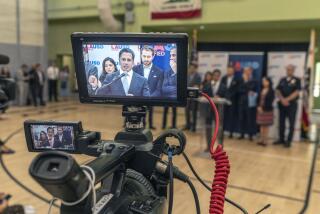Technology Speech Is Lost in Cyberspace : Education: Oxnard students waiting to hear Microsoft’s Bill Gates speak about their wired campus are foiled by unexplained snafu.
- Share via
OXNARD — Microsoft czar Bill Gates told most of the world Tuesday about the electronic wizardry that has set Blackstock Junior High School in Oxnard apart as a national leader in the use of educational technology.
But his hourlong speech in Washington missed one critical audience--the Blackstock students themselves.
Because of a technical foul-up, the satellite feed of Gates’ speech from Georgetown University never reached the students gathered to hear it in their “smart” classrooms.
It got lost in cyberspace.
“We’re still not exactly sure what happened, but we ended up with a sports program,” said Herb Gandara, assistant principal at Blackstock. “It was something like ‘The History of Sports.’ ”
Gates chose Blackstock as one of five school programs across the country that he said exemplify innovative use of technology in the classrooms. During his speech, Gates showed a video that included a five-minute segment on how Blackstock has integrated technology into the curriculum, said Wendy Lienhart, a spokeswoman for Microsoft.
The software giant will make that video available to school districts nationwide, she said. Blackstock came to Gates’ attention after he read an article featuring the model technology school in the October, 1995, issue of Architectural Digest, said Bob Noyes, a technology coordinator at Blackstock.
Microsoft sent two film crews to Blackstock last month to shoot footage of students using the vast array of computers, laser discs, VCRs, video cameras and televisions equipped with cable that make up its four smart classrooms.
The Hueneme School District has received about $3.5 million in state grants since 1990 to update technology at Blackstock and E. O. Green, the district’s other junior high school, Noyes said.
Gates’ speech Tuesday before 700 national education leaders and students at Georgetown University was his first major address unveiling his vision of how technology should be integrated into the classroom, Lienhart said.
He outlined his goal of improving education in the United States by linking homes, schools and the world via computers and the Internet. Parents can become more involved in their children’s education, for instance, by communicating with teachers via e-mail and bulletin boards, Gates said.
In addition to Blackstock, the other school programs selected by Gates for recognition were Christopher Columbus School in Union City, N.J., Fairfax County Special Needs Vocational Program and Thomas Jefferson Science and Technology Magnet High School in Alexandria, Va., and Sunman Elementary School in Sunman, Ind.
Microsoft officials were quick to deem Gates’ speech a success, saying it would motivate schools to bring technology into their classrooms.
But few seemed able to explain why the information giant was unable to deliver on its promised satellite feed to Blackstock.
“To be honest with you, we’re not quite sure why it didn’t work,” said Microsoft spokesman Jim Sarlo. “We talked to Georgetown University and they are trying to clear that problem up.”
But Georgetown officials placed the blame squarely in Microsoft’s window.
“They were handling the satellite transmissions from start to finish,” said Sandra Hvidsten, a university spokeswoman. “When you have experts in technology along, you let them take care of those things.”
Even U.S. Deputy Secretary of Education Madeline Kunin, who also made remarks at the event, seemed bewildered by the lost feed.
“You mean with Bill Gates at the helm there was still a glitch?” Kunin said.
Back at Blackstock, meanwhile, school officials were still awaiting word late Tuesday on when their students might get a chance to hear Gates’ speech. Microsoft told them to watch the evening newscasts to see if the address was picked up by one of the broadcast networks, Noyes said.
“It’s frustrating,” Noyes said. “But this is typical of technology. When you are depending on machines, you have to make contingencies.”
More to Read
Sign up for Essential California
The most important California stories and recommendations in your inbox every morning.
You may occasionally receive promotional content from the Los Angeles Times.














